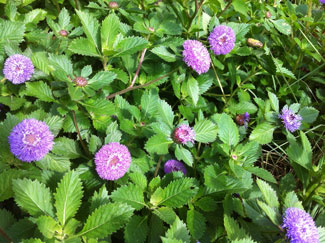Resource Library
Plant of the Week: Brazilian Button Flower

Brazilian Button Flower is a heat loving tender perennial that produces showy blue-purple flowers all season long. (Image courtesy Gerald Klingaman)
Plant of the Week
Brazilian Button Flower
Latin: Centratherum punctatum
Strolling through the Botanical Garden the other day, I spied a healthy, happy blue
flowered plant growing in a hot, relatively dry corner of the garden. It was new
to me. The plant, labeled as Centratherum ‘Pineapple Sangria’, had clean, distinctive foliage and was generously sprinkled with
distinctive thistle colored blue-purple flowers. Despite the lateness of the growing
season, the plant seemed to be just hitting its stride so obviously it was not averse
to growing in the heat of an Arkansas summer.
The genus Centratherum is a member of the daisy family and consists of about 20 species scattered around the equatorial belt of the globe. Though most internet sources list ‘Pineapple Sangria’ as a selection of C. intermedium, a species first described as coming from Central America and Columbia, it also is sometimes given the name Manaus Beauty after the northern Brazilian capitol along one of the Amazon’s principle tributaries, the Rio Negro.
C. punctatum was initially described as native to the Philippines and Australia. Today taxonomists consider these two species to be subspecies of the same plant with C. punctatum being the correct name.
Brazilian Button Flower is a freely branching tender perennial growing to 18 inches tall and 24 inches wide. Plants are hardy outside where winter temperatures do not drop below 25 degrees Fahrenheit, but even at that temperature the foliage will be killed by frost. It has 3-inch-long olive green leaves that have the fragrance of pineapple sage when crushed. The leaves have extravagantly serrate margins and look like they have been cut with pinking shears. The foliage fragrance and taste are reported to keep deer and rabbits at bay.
The 1.25-inch blue-purple flower heads are borne individually and scattered about the foliage, nested in a terminal whorl of five smaller leaves. Plants are never covered with flower heads as seen in composites such as marigolds, but they are produced over an extended season from June until frost in the temperate garden. The composite flower head is composed entirely of tubular, five-pointed disc florets that begin opening in consecutive whorls from the outside in. Small tan-colored egg shaped seeds are produced in a nest-like whorl of outer flowers.
The Brazilian Button Flower was described by botanists in the early 19th century but it did not gain a significant following amongst gardeners, instead being preserved as a pass-along plant in the subtropical areas. The first commercial reference I found of the plant was in the early 1990s but even then it was dropped after a few years because of poor sales. Since about 2000 it seems to have been rediscovered and there has been a spike, albeit a minor one, in interest about the plant. ‘Pineapple Sangria’, the first cultivar selected for better garden performance, seems to have helped spur interest in the plant.
Brazilian Button Flower is a sun- and heat-loving plant that grows best in well-drained, fertile garden soils. It can be used for massing in the border or to fill in spaces left by perennials that fade away as it gets hot. In subtropical areas it is used as a tall growing groundcover. Plants are easy to start from seed and blooming plants can be produced in about 14 weeks. It is reported to reseed especially in subtropical regions.
By: Gerald Klingaman, retired
Retired Extension Horticulturist - Ornamentals
Extension News - September 19, 2014
The University of Arkansas System Division of Agriculture does not maintain lists of retail outlets where these plants can be purchased. Please check your local nursery or other retail outlets to ask about the availability of these plants for your growing area.